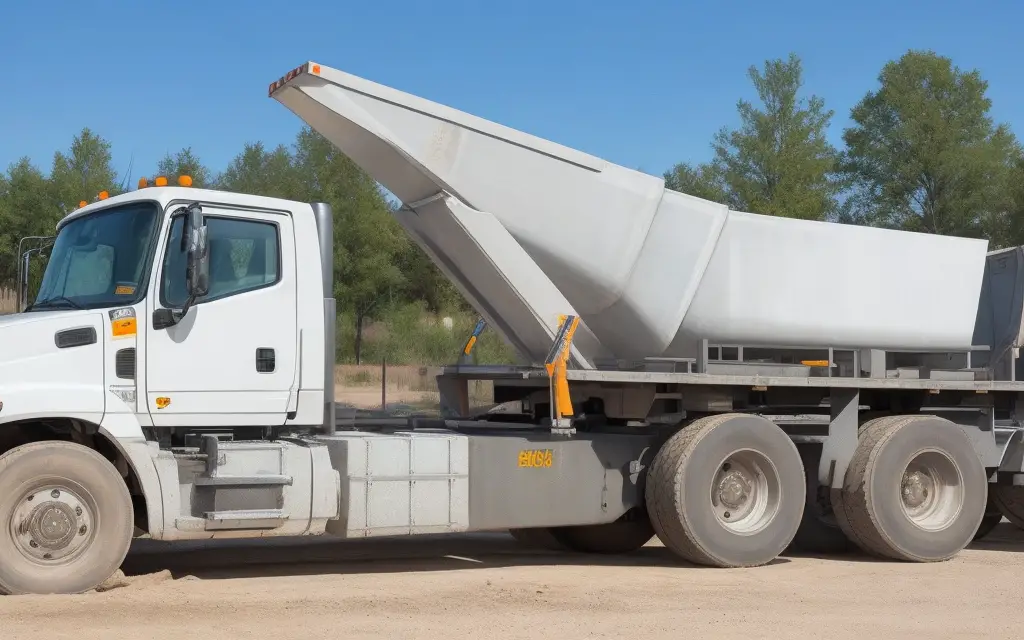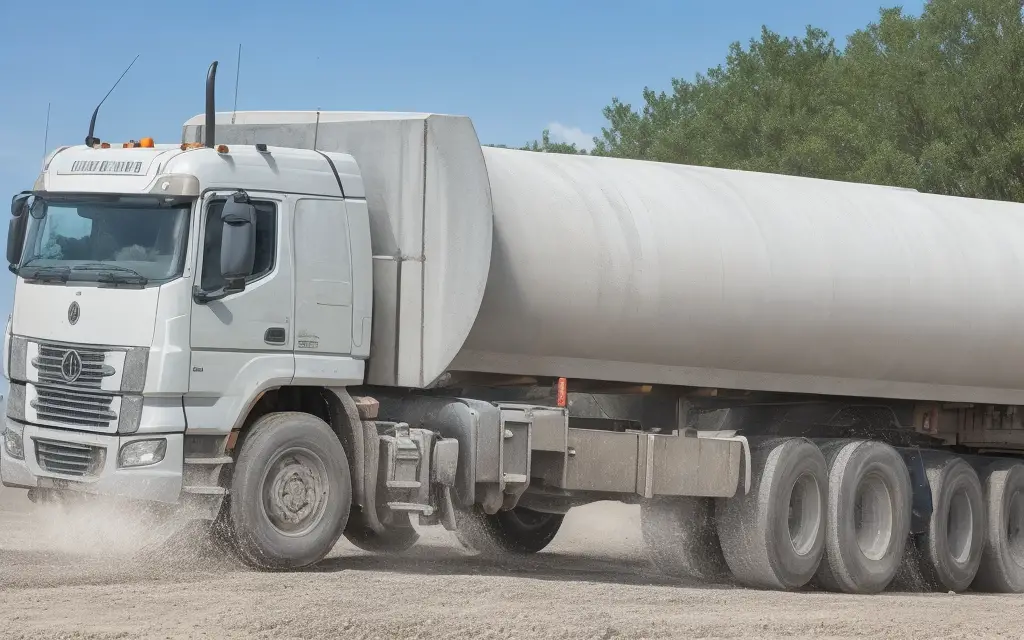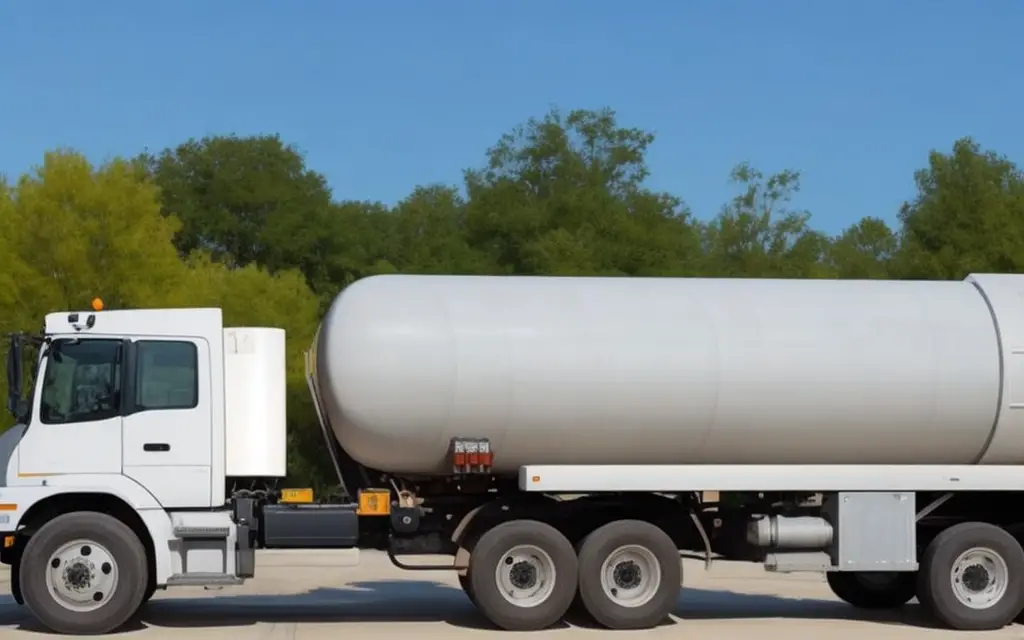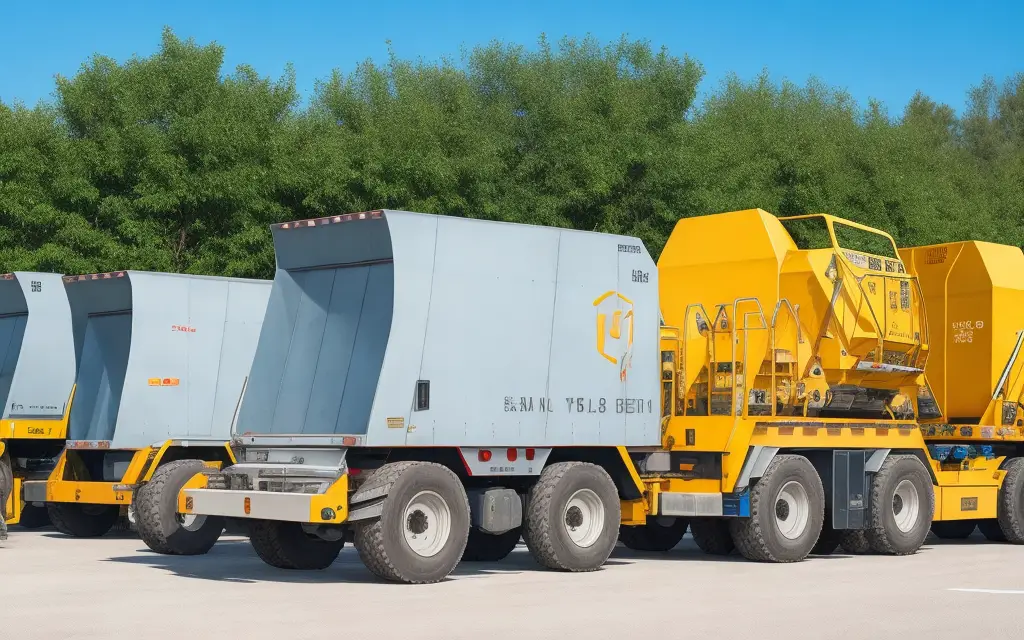A concrete truck, often referred to as a concrete mixer truck, is a specialized vehicle designed for the transportation of freshly mixed concrete from the batching plant to construction sites. These special trucks are like the workhorses of the construction world. The burning question is how much in a concrete is in a truck? often, They make sure that concrete, which is basically the bread and butter of building things, gets to where it’s needed on time and in just the right form.
These trucks come with some impressive features and techniques that contribute to the smooth operation of construction projects while ensuring the highest quality of work. In this introduction, we will delve deeper into the inner workings of these concrete trucks and understand why they hold such significant importance in the construction industry.
yard of concrete

A yard of concrete represents a soft, human-friendly measure of concrete, equivalent to a cube measuring 3 feet in length, 3 feet in width, and 3 feet in height, totaling 27 cubic feet of concrete. In most instances, everyday projects do not require an exact concrete cube, except for significant construction endeavors. Instead, it is more customary to pour or shape the concrete to fit the specific requirements of the project.
When considering a typical sidewalk, it’s common for it to be constructed with a thickness of five inches of concrete. To figure out how much concrete you’ll require for your project, you can find the volume by simply measuring the length, width, and depth of the intended sidewalk.
This volume can then be conveniently converted into cubic feet and yards of concrete.
The preference for dealing with yards of concrete is widespread among companies and buyers. This is primarily because it represents the smallest practical measurement for various construction projects. It is user-friendly in both written and spoken form, making it a convenient choice compared to working with dozens or hundreds of cubic feet. Importantly, it does not imply a level of precision that exceeds the capabilities of most concrete trucks.
It’s worth noting that in some other countries, meters are the standard unit of measurement for concrete, as they follow a different measuring system. A meter of concrete is approximately equivalent to 0.764555 cubic yards, or a bit more than three-quarters the volume of a yard. Consequently, trucks designed to carry meters of concrete may display slightly higher volume numbers on their high-capacity vehicles.
Varieties of Concrete Trucks

Mixer Trucks (Concrete Truck Mixers): Mixer trucks, often colloquially referred to as concrete truck mixers, are renowned for their role in blending raw materials and water within a rotating drum. This process ensures that the concrete remains consistently mixed and workable during transit to the construction site. While the drum can continuously rotate to prevent the concrete from setting, there are practical limits to how long it can do so.
Rear Discharge Mixer: Rear discharge mixers are distinguished by a substantial, rear-mounted drum that tilts upward to prevent concrete spillage while in motion. Loading these trucks from the top is straightforward, and hydraulic systems facilitate controlled pouring. Drivers of rear discharge mixers often require assistance, as visibility is limited, necessitating the help of a crew member to ensure precise positioning. These trucks’ advantage lies in their maneuverability on narrow roads, granting access to challenging job sites. Nonetheless, the driver needs to exit the vehicle to discharge the concrete.
Front Discharge Mixer: Front discharge trucks, while less common, offer similar efficiency. In these trucks, the loading and discharge processes occur at the front, providing drivers with better visibility for precise pouring. Hydraulic dumping systems in front discharge trucks are consistent with their rear discharge counterparts. These trucks are typically larger, which can limit their suitability on narrow roads. Drivers can discharge the contents without exiting the cabin, enhancing comfort, especially in adverse weather conditions. Front-loading trucks require more extended cleaning after each load to prevent concrete buildup. Their time-saving advantages in terms of positioning often result in quicker project runs compared to rear-discharge trucks.
Volumetric Mixer: Volumetric mixer trucks take a unique approach to concrete delivery. They feature separate compartments for cement, stone, sand, and water—the fundamental components of concrete. Instead of pre-mixing materials at a plant, volumetric mixers create the concrete on-site just before pouring it. This approach allows for precise measurements and flexibility since the mixing process can be halted at any point. Volumetric trucks are particularly valuable for smaller projects or as the final load for larger projects. They excel at accommodating last-minute adjustments in concrete volume requirements, eliminating the need to offload an entire load unnecessarily.
Mini Concrete Trucks: Mini concrete trucks, also known as “mini mix” trucks, are compact and highly maneuverable vehicles designed for transporting smaller quantities of concrete. They are commonly used for residential and light commercial projects where access is limited, and larger trucks may not be practical.
It’s crucial to recognize that volumetric mixers may not be the most time-efficient choice for projects that require the entire load. They tend to operate slightly more slowly than front or rear discharge mixers. Project managers carefully consider their project’s specific requirements and demands when selecting the most suitable type of concrete truck for the job, taking into account factors like maneuverability, precision, and time efficiency.
Understanding Concrete Truck Capacities

Concrete trucks come equipped with specific capacities, indicating the maximum amount of concrete they can transport in a single load. It’s essential to grasp these capacities, as they play a pivotal role in ensuring efficient concrete mixing and delivery. Here, we’ll explore the intricacies of concrete truck capacities in a more approachable and informative manner.
Determining Capacity:
The primary factor governing a concrete truck’s capacity is its size. Larger vehicles naturally have a higher concrete-holding capacity. Certain specialized designs may alter the size of the mixing drum or ingredient areas to meet specific project requirements. Constraints on capacity are more common when trucks need to accommodate unique features like extended chutes to ensure concrete reaches the project site.
Selecting the Right Truck:
Concrete companies typically sell their products by the yard and select trucks based on the project’s needs. They aim to match the truck’s capacity with the project’s concrete requirements to minimize waste and ensure efficient delivery.
Standard Truck Capacities:
Cement trucks are commonly manufactured in one-yard intervals. The smallest typical truck can carry three yards of concrete, while the largest standard options can transport up to sixteen yards. Trucks with capacities of eleven cubic yards are less common, with ten or twelve-cubic-yard options being more readily available. A single large truck is often more cost-effective to operate than multiple smaller ones, making it the preferred choice for most buyers. Smaller projects may require only one truck, whereas larger projects may necessitate the use of several trucks over an extended period.
Rated Capacities:
It’s important to note that a truck’s rated capacity differs from its maximum capacity. A truck rated for twelve yards can potentially hold slightly more, but overfilling can lead to various issues, including slowing down the mixing process, damaging truck components, and compromising concrete quality. Trucks require some empty space in the drum for effective mixing. When exceeding the rated capacity, it’s advisable to err on the side of caution and add slightly less material to the drum rather than overloading it.
Buildup:
Buildup refers to the residual concrete residue left inside a concrete truck after pouring. Although a quick wash after each pour helps minimize buildup, some residue is inevitable. Increased buildup reduces a truck’s effective capacity below its rated limit. To address this, companies may employ concrete chippers to clean the interior and remove as much buildup as possible.
Managing Capacity:
Buyers need not be overly concerned about capacity variations because concrete companies are committed to delivering the correct amount of concrete, often providing slightly more than required. Well-managed companies schedule periodic chipping to maintain optimal vehicle capacity and ensure a continuous supply of concrete for their projects.
Concrete Truck Capacity:
An average concrete truck typically carries a load ranging from eight to ten yards of concrete. These trucks come in varying sizes, with small trucks accommodating around 4 yards and larger trucks capable of transporting approximately 15 yards. This versatility allows concrete suppliers to cater to a wide range of project requirements, from small-scale residential tasks to more substantial commercial endea
vors.
Concrete Bag Equivalents:
Understanding the equivalence between bags of concrete and cubic yards is beneficial for project planning. It’s essential to note that it takes approximately 45 bags of 80lb Quikrete concrete to produce one cubic yard of concrete.When a concrete truck is fully loaded with ten yards, it contains the equivalent of 450 bags of 80lb concrete.
Pallet Quantities:
To provide a tangible perspective, it’s worth mentioning that 42 bags of 80lb concrete can fit on a single pallet, which is slightly less than one yard of concrete. Consequently, a fully loaded concrete truck carrying ten yards of concrete essentially contains over 10 ½ pallets of 80lb concrete.
Versatility and Project Adaptability:
The varying capacities of concrete trucks underscore their adaptability to different project sizes and scopes. Smaller trucks are well-suited for more compact construction tasks, while larger trucks efficiently handle larger-scale endeavors. This adaptability guarantees that we can deliver precisely the amount of concrete required to fulfill the unique requirements of every individual project.
Recognizing these intricacies of concrete truck capacities holds great importance in our efforts to plan projects effectively and ensure that concrete is delivered to its destination without excess or complications, ultimately contributing to successful construction operations.
Factors Influencing Concrete Truck Capacity

When we want to understand how much concrete a truck can carry, we need to take into account a few important aspects. It’s crucial to grasp these elements to ensure the smooth and effective delivery of concrete. Let’s explore these factors in a more human-friendly and informative way:
Truck Size:
The most apparent factor impacting a concrete truck’s capacity is its size. In general, larger trucks can transport more concrete, unless they possess unique designs tailored for specific purposes. It’s crucial to strike a balance, as excessively large trucks may struggle to navigate certain roads. In such cases, buyers might need to opt for multiple loads using smaller trucks to access the project site.
Weight:
Weight is directly linked to the size of the truck. Larger vehicles naturally weigh more, and when they are fully loaded with concrete, that weight increases further. Weight considerations hold importance as some roadways, particularly bridges, enforce stringent restrictions on vehicle weights. IIt’s worth mentioning that bigger trucks, even though they weigh more, usually spread their weight over a broader surface. This is kinder to the roadways and bridges they traverse. A small, heavily loaded truck can pose more risks to a bridge than a larger, heavier truck with a better weight distribution. This is why some trucks may carry less concrete than their theoretical capacity to ensure compliance with weight restrictions.
Distance:
In the United States, most concrete transportation adheres to ASTM C94, a specification standard governing ready-mixed concrete. This standard primarily applies to front and rear discharge mixers, while volumetric mixers, which mix concrete on-site, fall outside its scope.
ASTM C94 covers various aspects that companies must consider, including limits on the number of drum revolutions (usually 300), the content of delivery tickets, and the timing of quality-control sampling.
The actual travel distance matters less than the time required to cover that distance. Concrete mixers can cover considerable distances on rural highways, but urban traffic congestion can significantly reduce their effective travel distance. This is critical because most concrete should be poured within 90 minutes from the start of mixing to maintain quality. If concrete remains in the mixer for too long, its quality deteriorates.
Smaller or lighter trucks often have the advantage of faster travel, which affects their ability to reach the destination promptly. To ensure timely delivery and proper pouring, companies may opt to load a lesser amount of concrete into a truck, allowing it sufficient time to reach the destination and discharge its load without compromising quality.
By considering these factors, concrete companies can optimize their delivery processes and ensure that the right quantity of concrete reaches its destination safely and efficiently.
Determining the Quantity of Concrete in a Truck

When it comes to calculating the amount of concrete in a truck, there are some essential factors to consider that go beyond straightforward volume measurements. Let’s explore this process in more detail:
Consistency in Volume:
Concrete is known for its consistency in volume throughout the mixing and transportation process. This means that if you load a specific volume of concrete into the truck, you can generally expect to receive the same volume of concrete at the delivery site. Whether it’s seven yards going in, you can anticipate seven yards coming out.
Load Guidelines:
Most concrete trucks come equipped with clear guidelines specifying the minimum and maximum quantities of ingredients that can be loaded. These guidelines serve as reliable indicators of the expected output. By adhering to these guidelines, concrete suppliers ensure that the concrete produced meets the desired specifications and quality standards.
Measuring Challenges:
Measuring the exact volume of concrete in a truck while it’s in the mixing process can be a challenging task, even for experienced personnel. The dynamic nature of the mixing and the confined space within the truck’s drum make it difficult to obtain precise measurements. This is one of the primary reasons why concrete deliveries are accompanied by detailed receipts that provide comprehensive information about the loaded quantity, ensuring transparency and accuracy in the delivery process.
Quality Assurance:
Concrete suppliers and contractors prioritize accuracy in measuring the concrete quantity to maintain quality assurance. Making certain that we get just the correct quantity of concrete to the construction site is vital to fulfill the specific requirements of the project and maintain the structural soundness.
Deviations from the specified volume can lead to issues with concrete strength, consistency, and performance.
Documentation:
The documentation accompanying concrete deliveries serves as a critical record of the transaction. It typically includes vital information such as the volume of concrete delivered, the mix design, the time of batching, and the supplier’s details. This documentation not only provides proof of the delivered quantity but also assists in tracking and managing inventory and project progress.
Determining the quantity of concrete in a truck involves more than just volume calculations. It relies on clear load guidelines, meticulous measuring processes, and comprehensive documentation to ensure that the right amount of concrete is delivered to the construction site. This meticulous approach safeguards the quality and integrity of concrete in construction projects, making it an essential aspect of the concrete supply chain.
Exploring the Size of a Concrete Truck
In the realm of concrete transportation, it’s essential to comprehend the dimensions of a standard concrete truck. Here, we provide a detailed overview in a friendly and informative manner:
Height of a Standard Concrete Truck:
A standard concrete truck generally stands at a height of 8 to 9 feet. It’s worth noting that the height and length of a concrete truck can vary based on its size and design.
Weight of a Concrete Truck:
The weight of a concrete truck typically falls within the range of 27,000 to 40,000 pounds. This weight includes not only the vehicle itself but also the concrete payload it carries.
Capacity of a Concrete Truck:
A fully loaded concrete truck can carry a substantial amount of concrete, typically ranging from 8 to 10 cubic yards. This is really important in construction projects because it decides how much concrete we can bring to the construction site.
Variation in Size and Design: Concrete trucks come in various sizes and designs to cater to different project requirements. For instance, a standard pickup truck equipped with a 2-yard mixing body will have a height of approximately 8 feet. In contrast, a typical concrete truck incorporates a mixer, drum, and additional equipment, which can contribute to variations in its dimensions.
Understanding these dimensions is vital for construction professionals and project planners. It enables precise planning, ensuring that the right-sized concrete truck is deployed to meet the specific needs of each project, thereby contributing to the efficient and successful execution of construction tasks.
Conclusion
Concrete trucks, those colossal titans of construction, weave an intricate dance on the job site stage. Varied in size, from the delicate to the mammoth, they are the adaptable workhorses of the industry, fitting seamlessly into projects of all scales.
Yet, the real magic lies in their enigmatic relationship with concrete bags and pallets. This mystical bond holds the key to resource management nirvana, warding off the specter of overload. Balancing capacity and cargo is the tightrope walk of every successful construction venture.
In this labyrinth of logistics, meticulous planning shines as the guiding star. Safety and quality standards are our unwavering sentinels, ensuring that our construction odyssey concludes in triumph and alignment with our intended outcomes.
FAQs OF THE HOW MUCH IN A CONCRETE IS IN A TRUCK?
1. How much concrete can a typical concrete truck carry?
A typical concrete truck can carry between 8 to 10 cubic yards of concrete. The specific capacity may vary based on the size and design of the truck.
2. What determines the capacity of a concrete truck?
The primary factors determining a concrete truck’s capacity are its size and design. Smaller trucks usually carry around 4 cubic yards, while larger ones can transport up to 15 cubic yards.
3. How many bags of concrete are equivalent to one cubic yard of concrete?
It takes approximately 45 bags of 80lb Quikrete concrete to produce one cubic yard of concrete.
4. How can I calculate the amount of concrete I need for my project?
To calculate the concrete needed, measure the length, width, and depth of the area to be filled with concrete in feet. Then, multiply these dimensions to determine the cubic feet required. Divide this by 27 (the number of cubic feet in a cubic yard) to get the cubic yardage needed.
5. Are there any limitations to how much concrete a truck can carry safely?
Yes, concrete trucks should never be loaded beyond their designated carrying capacity. Overloading can lead to safety hazards, damage to the vehicle, and decreased concrete quality.
Concrete trucks, those colossal titans of construction, weave an intricate dance on the job site stage. Varied in size, from the delicate to the mammoth, they are the adaptable workhorses of the industry, fitting seamlessly into projects of all scales.
Yet, the real magic lies in their enigmatic relationship with concrete bags and pallets. This mystical bond holds the key to resource management nirvana, warding off the specter of overload. Balancing capacity and cargo is the tightrope walk of every successful construction venture.
In this labyrinth of logistics, meticulous planning shines as the guiding star. Safety and quality standards are our unwavering sentinels, ensuring that our construction odyssey concludes in triumph and alignment with our intended outcomes.

